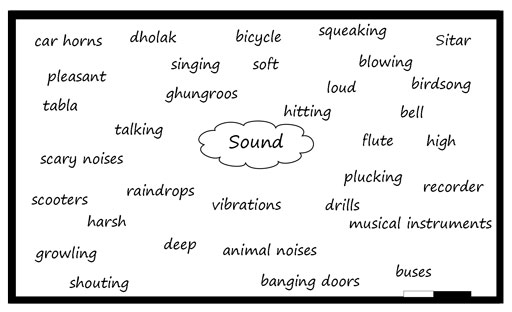1 What is brainstorming?
Brainstorming is a technique that encourages students to share their ideas about a topic. By using a single word or question, such as ‘sound’ or ‘How sound is made?’, you can ask the class to give you any ideas that come into their heads. As the students respond, all their answers are recorded on the blackboard by you (or a student), as shown in Figure 1.

Brainstorming can be done with a whole class – even a very large class – because all students can be given a chance to voice their ideas. Using the technique with groups or pairs is also possible. Allowing students a few minutes to talk with their neighbour about the topic before brainstorming can help them to think more deeply about what they know. As each student speaks, so others are stimulated to think more widely as they hear what is said. The key idea is to encourage students to think more deeply and creatively around a topic such as sound.
Now read Case Study 1, which shows how one teacher first experienced the technique and then used it with her class.
Case Study 1: Mrs Khan’s first experience of brainstorming
Mrs Khan relates how she first experienced brainstorming and how excited she was by the way it gave her confidence to talk in a big group. It also helped her to think more deeply about making her classes more interactive.
I first heard about brainstorming when I went on a course for a day about making my EVS lessons more interactive for my students. As a group of 20 teachers we were asked to brainstorm all the ideas that came to mind when the tutor wrote ‘interactive teaching’ on a blackboard. The tutor asked us to call out our thoughts as they came to mind and I was nervous at first about saying anything. As the tutor wrote all these words on the board, it made me think a lot about what had been said. I began to have my own ideas, so I said ‘sharing ideas’, which she said was a good idea. This comment made me feel more confident and so I began to offer other ideas. I had been to several in-service training days but had never spoken in them, so I was very pleased with myself.
Eventually the tutor had to stop writing, because the blackboard was full of a wide range of suggestions. She then looked very closely at our ideas and asked us if there were ways we could group these ideas, such as those that were for the teacher to do and those for students.
I found this a quite helpful way to organise the large number of ideas and strategies. During the rest of the day we focused on how to use some of these suggestions. One was how to brainstorm with my students, which I found really helpful. I went home thinking about how I might use the technique with my class. I decided to talk to a colleague who I often share ideas with about lessons and topics, before I had a try in my own class.
Mrs Khan was impressed by the experience she had and its impact on her. Try the next the activity with a colleague if possible.
Activity 1: Brainstorming on your own or with a colleague
Look at the next few topics you are going to teach in environmental science or science, and choose one where you think it would be useful to know what your students know already. Either on your own or preferably with another colleague who teaches the same grade or who is interested in using new and different strategies in the classroom, try to brainstorm what you know about sound (or another topic).
Say the word ‘sound’ out loud to yourself and listen to the ideas that spring into your mind. Write down these ideas. Do this fairly quickly as you talk with each other. After a few minutes, stop and look at what you have written.
Next, think about how you can group the words together. To do this you will need to think about what the focus of a lesson on sound might be and then group the words together according to the learning intentions. If you were exploring how sounds are made, you would group the words differently than if you were exploring the types of sound that different objects or animals make.
Also, discuss how the strategy made you both focus more on the topic of sound.
Pause for thought Did you enjoy doing this with your colleague? How much did it help you think of more ideas about sound? Think about how you might do this with your class or a group in your class. |
Why this approach is important
